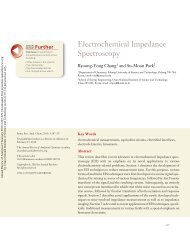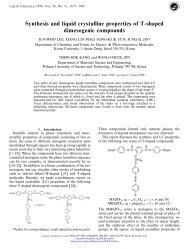Intercalation of Lithium Ions into Graphite Electrodes Studied by AC ...
Intercalation of Lithium Ions into Graphite Electrodes Studied by AC ...
Intercalation of Lithium Ions into Graphite Electrodes Studied by AC ...
Create successful ePaper yourself
Turn your PDF publications into a flip-book with our unique Google optimized e-Paper software.
2796 Journal <strong>of</strong> The Electrochemical Society, 146 (8) 2794-2798 (1999)<br />
S0013-4651(98)02-016-5 CCC: $7.00 © The Electrochemical Society, Inc.<br />
Figure 3. (a) Impedance responses recorded at the graphite electrode in 1.0<br />
M LiClO 4 in PC/EC at an x value <strong>of</strong> 0.33 in Li x C 6 at an open-circuit potential<br />
<strong>of</strong> 0.20 V; (b) an equivalent circuit describing the impedance responses<br />
shown in (a).<br />
The charge-transfer resistance, R CT , is related to the exchange<br />
current (i 0 ) <strong>by</strong> the equation 23a<br />
R CT � RT/(nFi 0 ) [3]<br />
The exchange current densities were calculated using Eq. 3 for various<br />
x values in Li x C 6 as listed in Table I. The result is shown in Fig.<br />
4. The exchange current densities range between 1.4 and 2.4 mA/cm 2<br />
and decrease monotonously with an increase in the x value <strong>of</strong> Li x C 6<br />
with some scattered points. The dependence <strong>of</strong> the exchange current<br />
on the amount <strong>of</strong> Li � is readily expected because <strong>of</strong> the different<br />
equilibrium potentials at the interface. While we found no reported<br />
exchange current density data for lithium intercalation <strong>into</strong> the<br />
graphite electrode in the literature, there are reports 6,24 about the<br />
charge-transfer resistance at various carbon electrodes determined <strong>by</strong><br />
ac impedance methods. These values were reported to range between<br />
5 and 20 � depending on the carbon types, which are in good agreement<br />
with ours listed in Table I. A similar but more drastic change in<br />
the exchange current has been reported <strong>by</strong> Colson et al. 25 for sodium<br />
intercalation in sodium molybdates. This result suggests that the<br />
interfacial charge-transfer process is associated with the electron<br />
transfer rather than the Li � transfer.<br />
Shown in Fig. 5 are the impedance spectra recorded at fresh electrodes<br />
(without preintercalation) in 0.1, 0.2, 0.5, 0.8, and 1.0 M<br />
LiClO 4 in the PC/EC mixed solvent at an applied potential <strong>of</strong> 0.20 V<br />
with no crown ethers added. The equivalent circuit presented in Fig.<br />
3b also applies to the data shown in Fig. 5. Values obtained for the<br />
various circuit elements at different LiClO 4 concentrations are listed<br />
in Table II. As expected, the solution resistance (R s ) estimated from<br />
the high-frequency intercept and the charge-transfer resistance (R 2 )<br />
obtained from the larger semicircle for the Li intercalation decrease<br />
as the Li � concentration increases in solution. The exchange current<br />
also increases with an increase in the Li � concentration as shown in<br />
Fig. 6. From the dependence <strong>of</strong> i 0 on the Li � concentration, one can<br />
calculate the transfer coefficient (�) for the Li intercalation process<br />
represented <strong>by</strong> Eq. 1. The relationship between the exchange current,<br />
i 0 , and the concentrations is 23<br />
i0 � nFk0C Li�<br />
(l��) �<br />
CLi While this equation is for solution species, it should be applicable to<br />
the interfacial electron transfer as the equilibrium potential at the elec-<br />
Table I. Values obtained for simulation <strong>of</strong> the elements in equivalent circuit shown in Fig. 6 at various x in Li x C 6 . a,b<br />
Open-circuit<br />
Q1 Q2 Q3 x in LixC6 potential, V R1 , � R2 , � Y, S n Y S n Y, S n x2 0.000 — 2.01 10.77 1.35 � 10 �4 0.858 6.82 � 10 �3 0.614 0.125 0.543 1.3 � 10 �3<br />
0.166 0.20 2.91 11.20 6.70 � 10 �4 0.676 6.53 � 10 �3 0.613 0.141 0.555 1.7 � 10 �4<br />
0.330 0.20 3.02 14.65 6.27 � 10 �4 0.702 6.51 � 10 �3 0.619 0.167 0.588 2.5 � 10 �4<br />
0.429 0.077 3.44 14.35 2.40 � 10 �4 0.808 5.91 � 10 �3 0.652 0.266 0.514 1.9 � 10 �4<br />
0.444 0.080 4.10 11.70 8.36 � 10 �4 0.649 5.32 � 10 �3 0.675 0.216 0.401 4.1 � 10 �4<br />
0.576 0.070 4.42 12.99 7.89 � 10 �4 0.661 4.97 � 10 �3 0.679 0.253 0.490 4.3 � 10 �4<br />
0.680 0.060 2.96 9.46 6.13 � 10 �4 0.704 5.63 � 10 �3 0.624 0.203 0.453 2.0 � 10 �4<br />
0.740 0.072 4.46 15.83 3.75 � 10 �3 0.547 5.10 � 10 �3 0.762 0.219 0.394 2.7 � 10 �4<br />
1.000 0.061 4.37 18.68 4.37 � 10 �4 0.928 6.14 � 10 �3 0.717 0.188 0.481 2.6 � 10 �4<br />
a Rs values are constant to 13.50 ∀ 1.0 �.<br />
b Impedance measurement under dc potential stepped to �0.2 V.<br />
Figure 4. The exchange current plotted vs. x in Li x C 6 .<br />
[4]




